RISE National was in full swing today, filled with timely updates for 2021 and 2022, an insightful keynote address, collaborative panel discussions, and so much more.

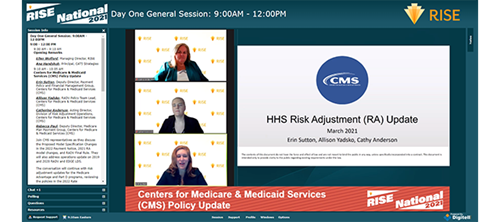
Our first session of the day featured updates from the Centers for Medicare & Medicaid Services (CMS) on both risk adjustment (RA) for the Affordable Care Act market and RA updates for Medicare Advantage and Part D program. CMS representatives reviewed the Proposed Model Specification Changes in the 2022 Payment Notice, 2021 RA model changes, and the RADV Final Rule. They also discussed operations updates on 2019 and 2020 RADV and EDGE LDS, policies in the 2022 Rate Announcement, and offered an overview on the CMS-HCC model 2022 risk score calculation.
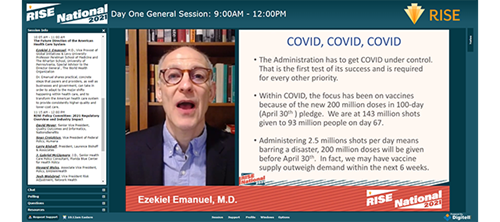
Next, we heard from health care policy expert Ezekiel J. Emanuel, M.D., who discussed the current progress on COVID-19 vaccines and predicted a sense of normalcy, given no distribution disruptions, by the end of the third quarter or into the early fourth quarter of 2021. Beyond COVID, Dr. Emanuel discussed potential areas for reform, such as primary care capitation, mental health care, and electronic health records and the creation of a patient smart card that could allow for real-time data monitoring of conditions and medical visits.
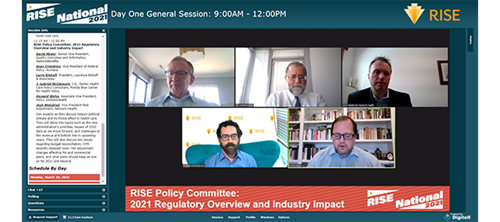
We continued the conversation of today’s political climate and its impact on health care with members of the RISE Risk Adjustment Policy Committee. The recently passed American Rescue Plan Act of 2021 was focused primarily on COVID-19 relief and getting the economy on track. Any significant Medicare provisions will take place in a second reconciliation bill, they said. Two areas to watch: potential payment cuts to Medicare Advantage and a proposal to expand original Medicare to cover dental, hearing, and vision. Updating original Medicare with the supplemental benefits currently offered by Medicare Advantage plans is both an opportunity and a threat. Medicare Advantage plans would have an opportunity to build on the benefits they already offer, but the rate of growth the industry has seen in recent years may not continue if original Medicare becomes more attractive to members.
Attendees then split into five concurrent tracks on risk adjustment strategies, provider/payer collaboration, digital health care delivery, social determinants of health (SDoH), and Quality, HEDIS®, and Stars. Topics included:
- The changing landscape of CMS risk adjustment and key tactics for 2021
- How advanced technologies and data analytics platforms drive more value in today’s value-based care arrangements
- Integrating health management with risk adjustment and quality
- A case study on the use of social determinants to improve member engagement, stars, and quality performance.
- Learning to connect the dots and transform SDoH data into big picture results
After participating in interactive, speed-networking style luncheon virtual roundtables featuring the latest technology solutions to boost risk, quality, and data management efforts, attendees jumped into a second round of concurrent track sessions including the following topics:
- How to use CMS reporting to optimize your risk adjustment strategy
- How to use data to improve care management and overall outcomes
- Developing KPIs for your prospective program
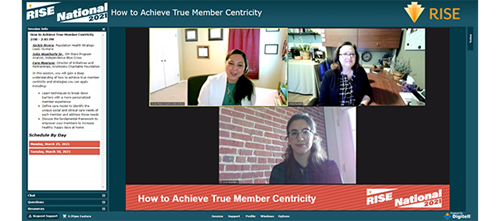
We also learned about in-home health risk assessment programs; bridging health care caps; effective strategies from 2020 risk adjustment; coding; and how advanced data science can predict disease. We also heard a panel discussion on how to achieve true member centricity, led by Signify Health’s Cindy Buckels, which focused on the need for community-based organizations and health plans to partner in strategies to address SDoH, and how public health work can happen with a grassroots approach in a business setting. Health care spending continues to rise, so it’s critical to take an innovative approach and address the 60 percent of what influences health, which is the social determinants,” said Buckels.
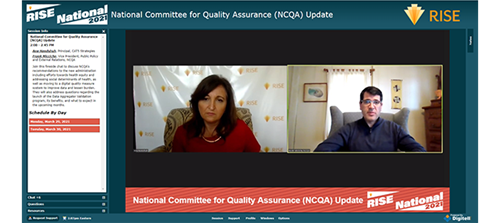
Frank Micciche, vice president, public policy and external relations, National Committee for Quality Assurance (NCQA), provided an update during a fireside chat with Conference Chair Ana Handshuh. He explained that the organization will now reference HEDIS by the measurement year or the year in which care is delivered, and proposed changes aimed to help close the gap on health equity. In addition, NCQA is working to close the gap on health equity and has proposed changes that would encourage organizations to focus on identifying whether there are disparities within their populations and if so, to make sure they are able to document and update what they are doing to address disparities. “Quality care is equitable care,” Micchiche said, noting you can’t have high-quality care if there are segments of your community that are underserved.
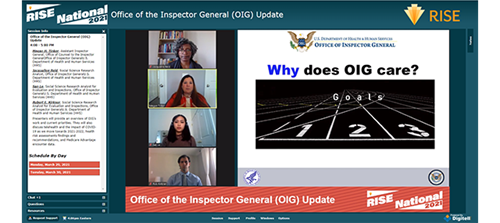
We joined together for the last session of the day, an update from the Office of the Inspector General (OIG). OIG representatives provided a look at the vulnerabilities in Medicare, particularly due to telehealth services during the COVID-19 public health emergency. The OIG has found risks within cost-sharing waivers for telehealth services, telehealth services that did not meet Medicare requirements, and kickback, medically unnecessary services/items.
They also went over the findings from recent OIG risk adjustment audits for Essence Healthcare, Inc. and Blue Cross Blue Shield of Michigan, which revealed that some of the diagnosis codes submitted for use in the Centers for Medicare & Medicaid Services’ risk adjustment program didn’t comply with federal requirements. Diagnosis codes submitted either weren’t supported in the medical records or couldn’t be supported because the medical records couldn’t be located.
Attendees ended the day at a virtual cocktail reception in the Networking Lobby to enjoy an evening of face-to-face networking with fellow attendees, speakers, and solutions providers.
